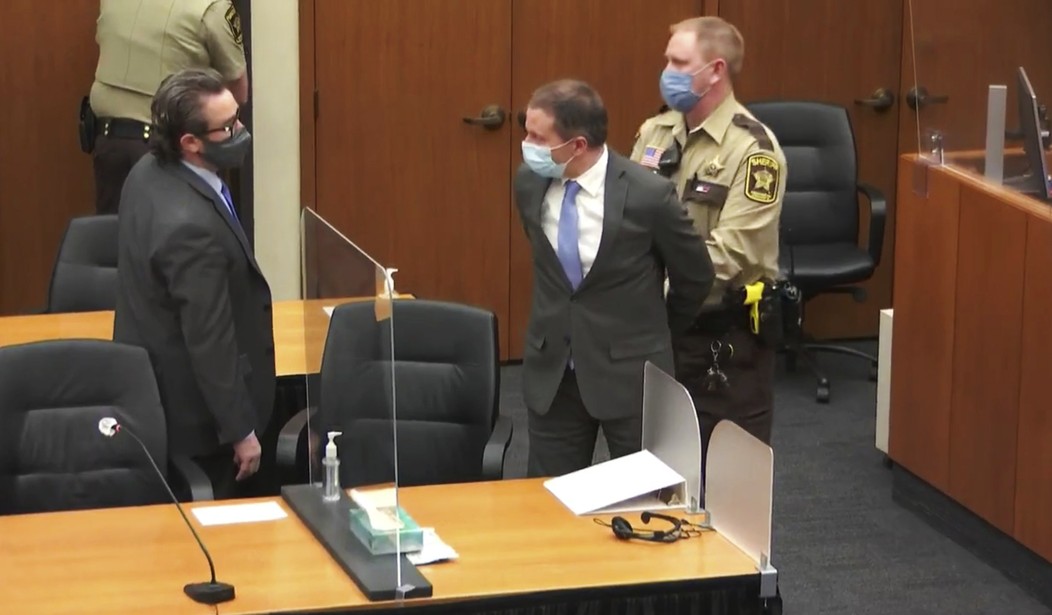A Minnesota jury has found Derek Chauvin guilty on all counts. Chauvin was afforded the process to which he was due. After a mere 10 hours of deliberations, this jury made short work of sorting through the evidence and the wisdom of their verdict will be tested by appellate courts and historians.
This swift verdict, however, does not mean the Chauvin defense was without merit nor was the prosecution’s case cut and dry. A different jury could have decided differently. Why? Because police use of force is oftentimes not as clear cut as the knee-jerk reactionists would have you believe. In fact, it usually resides somewhere in the gray area. I recently tweeted that I didn't envy Derek Chauvin's lawyers having to rely on the nebulous legalities surrounding the issue of "causation" because the application of that legal term of art is always in the eye of the beholder - or in this case, as determined by the subjective determination of the particular prosecutor and ultimately the trial jury.
The three charges brought by the Chauvin prosecutor were:
- Second Degree Unintentional Murder - alleges Chauvin caused Floyd's death without intent while committing or attempting to commit felony third-degree assault in that he committed the intentional infliction of substantial bodily harm.
- Third-degree murder - alleges Chauvin caused Floyd's death by "perpetrating an act eminently dangerous to others and evincing a depraved mind, without regard for human life."
- Second-degree manslaughter - alleges Chauvin caused Floyd's death by "culpable negligence whereby the person creates an unreasonable risk, and consciously takes chances of causing death or great bodily harm."
To be clear – this case was not a “whodunnit.” We know someone tragically died and there was no mystery that needed to be solved. But there was much left to be decided.
Recommended
Let’s have a look at all the words in those charges that required this jury to make a judgement call.
- Intentional
- Substantial
- Eminently dangerous
- Depraved Mind
- Without regard
- Unreasonable
Twelve people could consider the same evidence as presented in court and conceivably have 12 different opinions as to whether these words apply to the circumstances of Mr. Floyd’s tragic death. There is one word though that is the ultimate in legal wiggle words: causation.
Each charge contains the essential element of causation. This means that as to each charge the prosecution needed to prove beyond a reasonable doubt that Derek Chauvin caused the death of Mr. Floyd. More precisely, the prosecution had to prove that Chauvin’s actions were a “substantial causal factor” and when you have so many different factors that all converge at the moment of someone’s death, causation can often be difficult to prove to one person with any degree of certainty – let alone to a group of 12.
Outside the context of the Chauvin case, the legal analysis of police use of force in general is not only fact-dependent, it is highly dependent on the specific circumstances faced by the officer on-scene. In Graham v Conner, Justice Rehnquist told us that police use of force is to be judged not with the clear vision of 20/20 hindsight, but to use an objective standard. In other words, to view it from the perspective of the officer on scene in the heat of the moment and then ask: what would a hypothetical objectively reasonable officer do in like or similar circumstances?
“The calculus of reasonableness must embody allowance for the fact that police officers are often forced to make split-second judgments – in circumstances that are tense, uncertain and rapidly evolving – about the amount of force that is necessary in a particular situation,” he said. “The test of reasonableness is not capable of precise definition or mechanical application.”
This is known as the “objective reasonableness” standard. As if this weren’t confusing enough on its own, we are left to our own devices to imagine in our minds this hypothetical – if not mythical – perfectly reasonable police officer who always makes the right judgment call, to place said officer inside our factual scenario, and then discern for ourselves whether our imaginary perfectly-reasonable officer would have done the same or substantially the same thing as the real-life officer.
In other words – it’s not cut and dry. So, when the next police officer is the focus of every headline and every Twitter blue check mark tells you to be outraged, consider keeping an open mind, letting a thorough investigation uncover all relevant facts and circumstances and letting the administrative and legal processes run their course.

























Join the conversation as a VIP Member